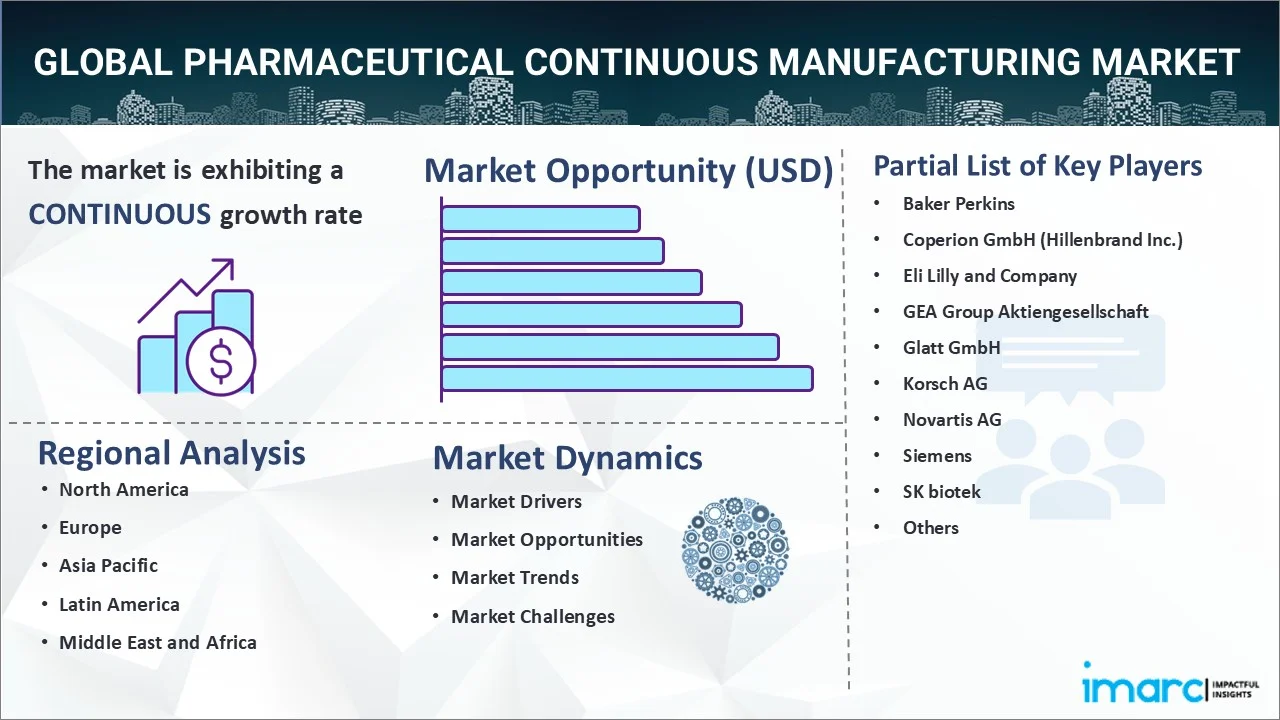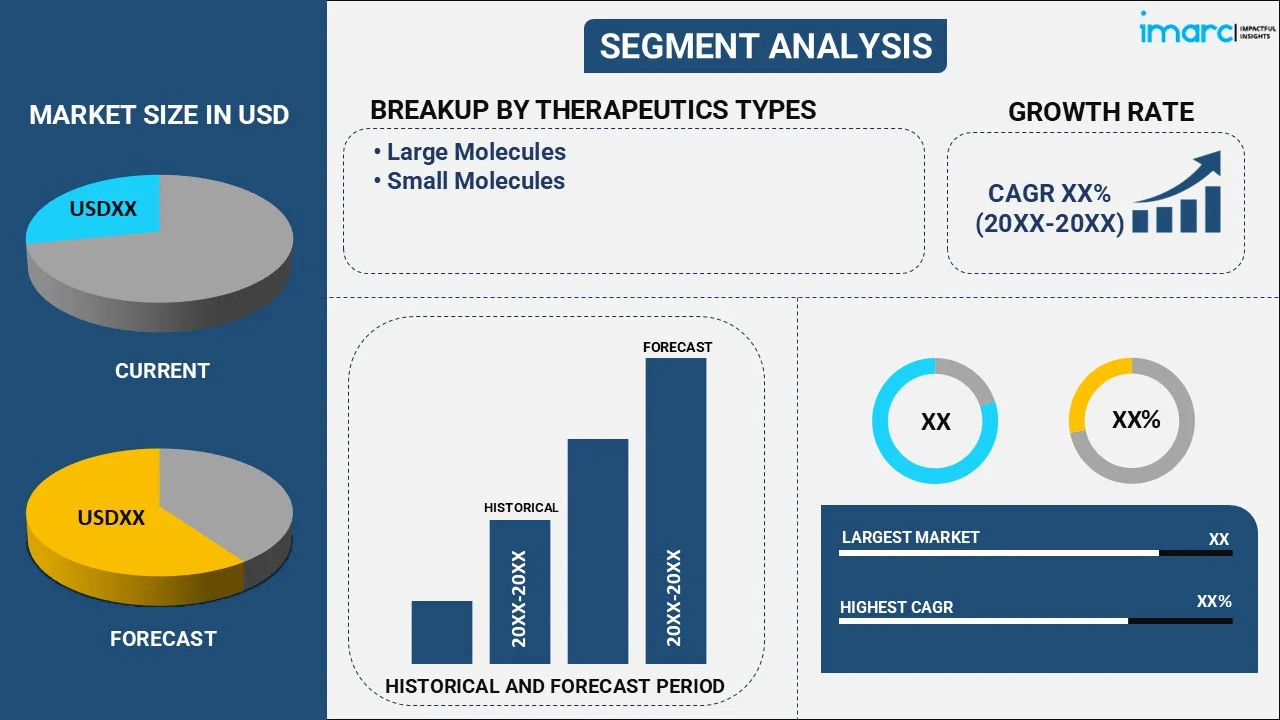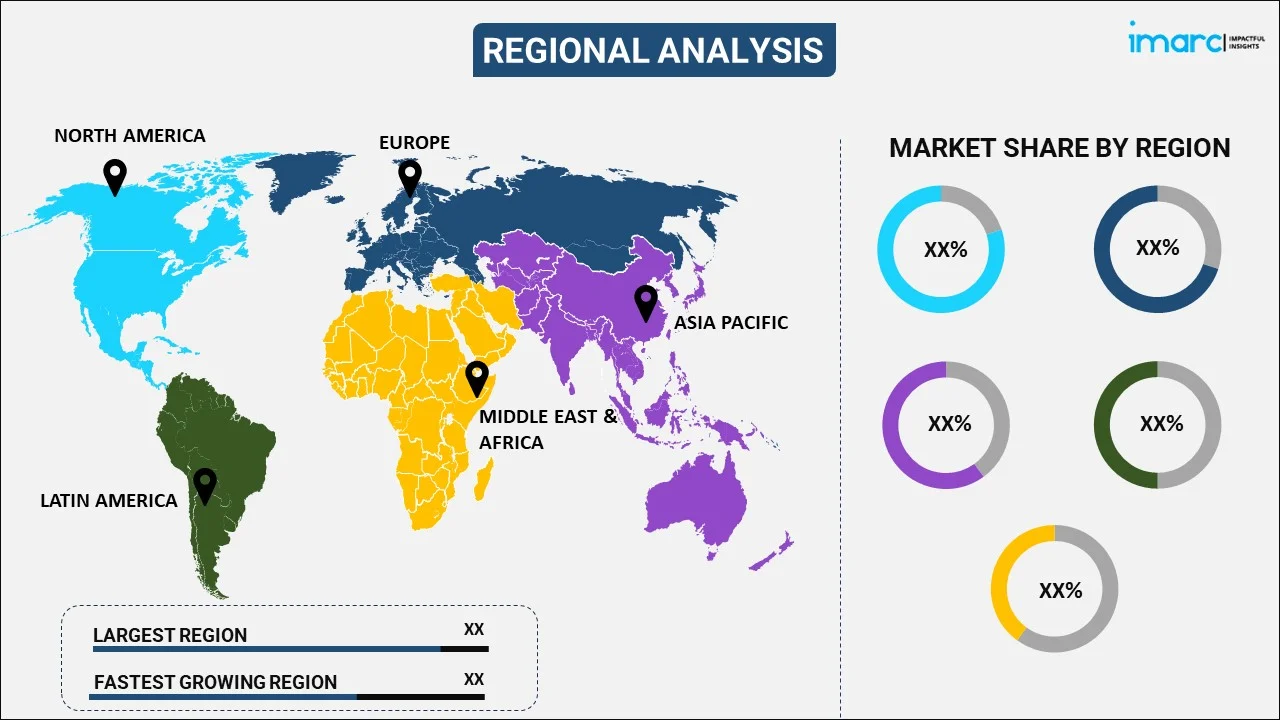
Pharmaceutical Continuous Manufacturing Market Report by Therapeutics Type (Large Molecules, Small Molecules), Formulation (Solid Formulation, Liquid and Semi-solid Formulation), Application (Final Drug Product Manufacturing, API Manufacturing), End User (Pharmaceutical Companies, Contract Manufacturing Organizations, and Others), and Region 2025-2033
Global Pharmaceutical Continuous Manufacturing Market:
The global pharmaceutical continuous manufacturing market size reached USD 1.5 Billion in 2024. Looking forward, IMARC Group expects the market to reach USD 3.3 Billion by 2033, exhibiting a growth rate (CAGR) of 9.62% during 2025-2033. The rising health concerns and the increasing research and development activities are propelling the market growth.
|
Report Attribute
|
Key Statistics
|
|---|---|
|
Base Year
|
2024 |
|
Forecast Years
|
2025-2033
|
|
Historical Years
|
2019-2024
|
| Market Size in 2024 | USD 1.5 Billion |
| Market Forecast in 2033 | USD 3.3 Billion |
| Market Growth Rate (2025-2033) | 9.62% |
Pharmaceutical Continuous Manufacturing Market Analysis:
- Major Market Drivers: Regulatory agencies are supportive of continuous manufacturing due to its potential to enhance product quality, reduce contamination risks, and provide real-time monitoring of the production process.
- Key Market Trends: The rising demand for effective medicine production systems is positively impacting the market growth.
- Competitive Landscape: Some of the prominent companies in the market include Baker Perkins, Coperion GmbH (Hillenbrand Inc.), Eli Lilly and Company, GEA Group Aktiengesellschaft, Glatt GmbH, Korsch AG, Novartis AG, Siemens, SK biotek, Thermo Fisher Scientific Inc., and Viatris Inc., among many others.
- Geographical Trends: North America exhibits a clear dominance in the market due to its advanced technological infrastructure. Apart from this, the region’s highly skilled workforce and strong regulatory support accelerate the market growth.
- Challenges and Opportunities: The high cost of systems is hindering the market. However, industry collaborations and shared resources help in distributing the cost and knowledge, which strengthens the market growth.

Pharmaceutical Continuous Manufacturing Market Trends:
Innovation in Drug Delivery System
Modern advances in drug delivery systems, like advanced materials, process analytical technology (PAT), and targeted nanomedicine, enable continuous production lines to produce drugs with improved targeted delivery, stability, real-time monitoring, and solubility. Collectively, these factors accelerate the market. For instance, an article published by the National Library of Medicine in May 2024 mentioned that focusing on technologies, such as liposomes and lipid nanoparticles (LNPs) and development in smart, carrier-based, and 3D-printed drug delivery methods improve bioavailability, address conventional limitations, and advance research.
Regulatory Support in Manufacturing Process
Regulatory bodies have increasingly acknowledged the benefits of continuous manufacturing, like product consistency and enhanced efficiency. These agencies established comprehensive guidelines and programs that provide clear standards and regulatory pathways for implementing continuous manufacturing technologies. For instance, in May 2024, the U.S. Food and Drug Administration (FDA) launched the START pilot program to accelerate the development of rare disease therapeutics. It focuses on clinical trial support and regulatory guidance, which benefits continuous manufacturing by accelerating novel product development and optimizing production requirements, which is increasing the pharmaceutical continuous manufacturing market statistics.
Increasing Incidence of Chronic Disease
As chronic conditions such as cardiovascular diseases, diabetes, and chronic respiratory diseases become more prevalent, there is an increased demand for reliable and long-term treatments. Continuous manufacturing processes meet this demand due to their ability to produce quality pharmaceuticals at scale with efficiency and consistent quality. In line with this, the adoption of pharmaceutical continuous manufacturing price trends reduces production costs and waste, thereby making treatments more affordable and accessible. For example, research published by Public Health Research in February 2024 showed that approximately 129 million people in the United States have at least one major chronic disease.
Global Pharmaceutical Continuous Manufacturing Industry Segmentation:
IMARC Group provides an analysis of the key trends in each segment of the market, along with the pharmaceutical continuous manufacturing market forecast at the global, regional, and country levels for 2025-2033. Our report has categorized the market based on therapeutics type, formulation, application, and end user.
Breakup by Therapeutics Type:

- Large Molecules
- Small Molecules
Small molecules dominate the pharmaceutical continuous manufacturing market
The report has provided a detailed breakup and analysis of the market based on the therapeutics type. This includes large molecules and small molecules. According to the report, small molecules represented the largest market segmentation.
Continuous manufacturing enhances efficiency and consistency in small-molecule drugs. Vertex Pharmaceuticals introduced Suzetrigine, a small molecule drug manufactured using continuous processes, optimizing production efficiency and ensuring consistent quality for pain management.
Breakup by Formulation:
- Solid Formulation
- Liquid and Semi-solid Formulation
Solid formulation currently holds most of the pharmaceutical continuous manufacturing market demand
The report has provided a detailed breakup and analysis of the market based on the formulation. This includes solid formulation and liquid and semi-solid formulation. According to the report, solid formulation represented the largest market segmentation.
Solid formulations, such as capsules and tablets, excel in continuous manufacturing due to improved consistency and efficiency. For example, XenoPharma’s tablet production ensures uniform quality and scalable output, which is acting as another significant growth-inducing factor.
Breakup by Application:
- Final Drug Product Manufacturing
- API Manufacturing
Final drug product manufacturing dominates the market
The report has provided a detailed breakup and analysis of the market based on the application. This includes final drug product manufacturing and API manufacturing. According to the report, final drug product manufacturing represented the largest market segmentation.
Final drug product manufacturing in continuous processes ensures efficient production with consistent quality and scalability, thereby reducing waste and enhancing overall process control. It also results in cost savings. This is bolstering the pharmaceutical continuous manufacturing market revenue.
Breakup by End User:
- Pharmaceutical Companies
- Contract Manufacturing Organizations
- Others
Pharmaceutical companies hold most of the pharmaceutical continuous manufacturing market outlook
The report has provided a detailed breakup and analysis of the market based on the end user. This includes pharmaceutical companies, contract manufacturing organizations, and others. According to the report, pharmaceutical companies represented the largest market segmentation.
Pharmaceutical companies increasingly adopt continuous manufacturing to enhance efficiency, streamline production processes, and ensure consistent product quality. This is leading to faster and more cost-effective drug development.
Breakup by Region:

- North America
- United States
- Canada
- Asia-Pacific
- China
- Japan
- India
- South Korea
- Australia
- Indonesia
- Others
- Europe
- Germany
- France
- United Kingdom
- Italy
- Spain
- Russia
- Others
- Latin America
- Brazil
- Mexico
- Others
- Middle East and Africa
North America exhibits a clear dominance, accounting for the largest pharmaceutical continuous manufacturing market share
The market research report has also provided a comprehensive analysis of all the major regional markets, which include North America (the United States and Canada); Asia Pacific (China, Japan, India, South Korea, Australia, Indonesia, and others); Europe (Germany, France, the United Kingdom, Italy, Spain, Russia, and others); Latin America (Brazil, Mexico, and others); and the Middle East and Africa. According to the report, North America accounted for the largest market share.
As per the pharmaceutical continuous manufacturing market research report, North America accounted for the largest share, driven by advanced drug delivery technologies. Moreover, regulatory bodies in the region are highly supportive of continuous manufacturing practices. The corporation with regulatory bodies encourages pharmaceutical companies to adopt continuous manufacturing solutions, thereby propelling the market growth. For instance, in May 2024, the U.S. Food and Drug Administration (FDA) introduced the START pilot program to catalyze the development of rare disease therapeutics.
Competitive Landscape:
The market research report has provided a comprehensive analysis of the competitive landscape. Detailed profiles of all major market pharmaceutical continuous manufacturing companies have also been provided. Some of the key players in the market include:
- Baker Perkins
- Coperion GmbH (Hillenbrand Inc.)
- Eli Lilly and Company
- GEA Group Aktiengesellschaft
- Glatt GmbH
- Korsch AG
- Novartis AG
- Siemens
- SK biotek
- Thermo Fisher Scientific Inc.
- Viatris Inc.
(Please note that this is only a partial list of the key players, and the complete list is provided in the report.)
Pharmaceutical Continuous Manufacturing Market Recent Developments:
- June 2024: Aurobindo Pharma USA partnered with MSD (Merck & Co., Inc.) to advance biologics manufacturing to improve the production capabilities for biologic therapies through the continuous manufacturing process.
- May 2024: L.B. Bohle introduced the QbCon system, a pharmaceutical continuous manufacturing line. This state-of-the-art line features a modular design capable of direct compression and wet and dry granulation, accommodating a quantity of 5 to 25 kg/h.
- May 2024: The U.S. Food and Drug Administration (FDA) launched the START pilot program to accelerate the development of rare disease therapeutics, which benefits continuous manufacturing by accelerating novel product development.
Pharmaceutical Continuous Manufacturing Market Report Scope:
| Report Features | Details |
|---|---|
| Base Year of the Analysis | 2024 |
| Historical Period | 2019-2024 |
| Forecast Period | 2025-2033 |
| Units | Billion USD |
| Scope of the Report | Exploration of Historical Trends and Market Outlook, Industry Catalysts and Challenges, Segment-Wise Historical and Predictive Market Assessment:
|
| Therapeutics Types Covered | Large Molecules, Small Molecules |
| Formulations Covered | Solid Formulation, Liquid and Semi-solid Formulation |
| Applications Covered | Final Drug Product Manufacturing, API Manufacturing |
| End Users Covered | Pharmaceutical Companies, Contract Manufacturing Organizations, Others |
| Regions Covered | Asia Pacific, Europe, North America, Latin America, Middle East and Africa |
| Countries Covered | United States, Canada, Germany, France, United Kingdom, Italy, Spain, Russia, China, Japan, India, South Korea, Australia, Indonesia, Brazil, Mexico |
| Companies Covered | Baker Perkins, Coperion GmbH (Hillenbrand Inc.), Eli Lilly and Company, GEA Group Aktiengesellschaft, Glatt GmbH, Korsch AG, Novartis AG, Siemens, SK biotek, Thermo Fisher Scientific Inc., Viatris Inc., etc. |
| Customization Scope | 10% Free Customization |
| Post-Sale Analyst Support | 10-12 Weeks |
| Delivery Format | PDF and Excel through Email (We can also provide the editable version of the report in PPT/Word format on special request) |
Key Benefits for Stakeholders:
- IMARC's industry report offers a comprehensive quantitative analysis of various market segments, historical and current market trends, market forecasts, and dynamics of the pharmaceutical continuous manufacturing market from 2019-2033.
- The research report provides the latest information on the market drivers, challenges, and opportunities in the global pharmaceutical continuous manufacturing market.
- The study maps the leading, as well as the fastest-growing, regional markets. It further enables stakeholders to identify the key country-level markets within each region.
- Porter's five forces analysis assists stakeholders in assessing the impact of new entrants, competitive rivalry, supplier power, buyer power, and the threat of substitution. It helps stakeholders to analyze the level of competition within the pharmaceutical continuous manufacturing industry and its attractiveness.
- The competitive landscape allows stakeholders to understand their competitive environment and provides insight into the current positions of key players in the market.
Key Questions Answered in This Report
The global pharmaceutical continuous manufacturing market was valued at USD 1.5 Billion in 2024.
We expect the global pharmaceutical continuous manufacturing market to exhibit a CAGR of 9.62% during 2025-2033.
The rising demand for pharmaceutical continuous manufacturing, as it aids in minimizing the medicine formulation duration, monitoring the production procedures, and improving the product quality to harmonize with the regulatory guidelines, is primarily driving the global pharmaceutical continuous manufacturing market.
The sudden outbreak of the COVID-19 pandemic has led to the growing adoption of pharmaceutical continuous manufacturing techniques by various pharmaceutical companies to manufacture novel vaccines against the coronavirus infection.
Based on the therapeutics type, the global pharmaceutical continuous manufacturing market has been divided into large molecules and small molecules. Currently, small molecules currently exhibit a clear dominance in the market.
Based on the formulation, the global pharmaceutical continuous manufacturing market can be categorized into solid formulation and liquid and semi-solid formulation, where solid formulation accounts for the majority of the global market share.
Based on the application, the global pharmaceutical continuous manufacturing market has been segregated into final drug product manufacturing and API manufacturing. Currently, final drug product manufacturing currently holds the largest market share.
Based on the end user, the global pharmaceutical continuous manufacturing market can be bifurcated into pharmaceutical companies, contract manufacturing organizations, and others. Among these, pharmaceutical companies exhibit a clear dominance in the market.
On a regional level, the market has been classified into North America, Asia-Pacific, Europe, Latin America, and Middle East and Africa, where North America currently dominates the global market.
Some of the major players in the global pharmaceutical continuous manufacturing market include Baker Perkins, Coperion GmbH (Hillenbrand Inc.), Eli Lilly and Company, GEA Group Aktiengesellschaft, Glatt GmbH, Korsch AG, Novartis AG, Siemens, SK biotek, Thermo Fisher Scientific Inc., and Viatris Inc.
Need more help?
- Speak to our experienced analysts for insights on the current market scenarios.
- Include additional segments and countries to customize the report as per your requirement.
- Gain an unparalleled competitive advantage in your domain by understanding how to utilize the report and positively impacting your operations and revenue.
- For further assistance, please connect with our analysts.
 Inquire Before Buying
Inquire Before Buying
 Speak to an Analyst
Speak to an Analyst
 Request Brochure
Request Brochure
 Request Customization
Request Customization




.webp)




.webp)












